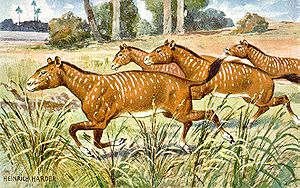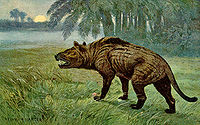
Oligocene
Did you know...
SOS Children have produced a selection of wikipedia articles for schools since 2005. Sponsoring children helps children in the developing world to learn too.
The Oligocene epoch is a geologic period that extends from about 33.9 million to 23 million years before the present. As with other older geologic periods, the rock beds that define the period are well identified but the exact dates of the start and end of the period are slightly uncertain. The name Oligocene comes from the Greek ὀλίγος (oligos, few) and καινός (kainos, new), and refers to the sparsity of additional modern mammalian faunas after a burst of evolution during the Eocene. The Oligocene follows the Eocene epoch and is followed by the Miocene epoch. The Oligocene is the third and final epoch of the Paleogene period.
The Oligocene is often considered an important time of transition, a link between "[the] archaic world of the tropical Eocene and the more modern-looking ecosystems of the Miocene."(Haines) The Oligocene change in ecosystems is a global expansion of grasslands, and a regression of tropical broad leaf forests to the equatorial belt.
The start of the Oligocene is marked by a major extinction event, a faunal replacement of European with Asian fauna except for the endemic rodent and marsupial families called the Grande Coupure. The Oligocene-Miocene boundary is not set at an easily identified worldwide event but rather at regional boundaries between the warmer Oligocene and the relatively cooler Miocene.
| Paleogene Period | ||
|---|---|---|
| Paleocene Epoch | Eocene Epoch | Oligocene Epoch |
| Danian | Selandian Thanetian |
Ypresian | Lutetian Bartonian | Priabonian |
Rupelian | Chattian |
Subdivisions
Oligocene faunal stages from youngest to oldest are:
| Chattian or Late Oligocene | (28.4 ± 0.1 – 23.03 mya) |
| Rupelian or Early Oligocene | (33.9 ± 0.1 – 28.4 ± 0.1 mya) |
Climate
Climates remained warm, although the slow global cooling that eventualty led to the Pleistocene glaciations started around the end of the epoch.
The Oligocene Epoch temperature is a clearly defined notch in a general temperature decline across the Paleogene Period. Evidence indicates a galactic causal. From 3C321 (NASA, 2007), a Black Hole Quasar was found to emit relativistic ISM particles in a narrow beam at about distances equal to our Sol Galactic core distance. Glaciating (cooling) is a result of ISM Heliosphere reduction and ISM penetration (PCFrisch, 2006). The Oligocene is the Neotectonic cycle of a 220million year planetary equidistant rupture (PER) geologic cycle (Kvet, 1991), extending to 4650Ma (Million years ago). These likely coincide with a Galactic Central Bar alignment at Sol. The Oligocene Grande Coupure, is summarized as a faunal divide replacement of European with Asian fauna except for the endemic rodent family. The Oligocene, a biosphere stressed by temperature and probable reduction of Heliosphere Gamma Ray shielding is understandably an epoch of few new species.
Paleogeography
During this period, the continents continued to drift toward their present positions. Antarctica continued to become more isolated and finally developed a permanent ice cap.(Haines)
Mountain building in western North America continued, and the Alps started to rise in Europe as the African plate continued to push north into the Eurasian plate, isolating the remnants of Tethys Sea. A brief marine incursion marks the early Oligocene in Europe. Oligocene marine exposures are rare in North America. There appears to have been a land bridge in the early Oligocene between North America and Europe since the faunas of the two regions are very similar. During sometime in the Oligocene, South America was finally detached from Antarctica and drifted north towards North America. It also allowed the Antarctic Circumpolar Current to flow, rapidly cooling the continent.
Flora
Angiosperms continued their expansion throughout the world; tropical and sub-tropical forests were replaced by temperate deciduous woodlands. Open plains and deserts became more common. Grasses expanded from the water-bank habitat in the Eocene and moved out into open tracts; however even at the end of the period it was not quite common enough for modern savanna.(Haines)
In North America, subtropical species dominated with cashews and lychee trees present, and temperate trees such as roses, beech and pine were common. The legumes of the pea and bean family spread, and sedges, bulrushes and ferns continued their ascent.
Fauna
Important Oligocene land faunas are found on all continents except Australia. Even more open landscapes allowed animals to grow to larger sizes than they had earlier in the Paleogene.(Haines) Marine faunas became fairly modern, as did terrestrial vertebrate faunas in the northern continents. This was probably more as a result of older forms dying out than as a result of more modern forms evolving.
South America was apparently isolated from the other continents and evolved a quite distinct fauna during the Oligocene.
Reptiles were abundant in the Oligocene. Choristodera, a group of semi- aquatic, crocodile-like, diapsid ( archosauromorph?) reptiles originated in the Jurassic, possibly as far back as Late Triassic. Early in the Oligocene, the Choristodera became extinct, possibly due to climate changes. Snakes and lizards did diversify to a degree.
Mammals included: Brontotherium, Indricotherium, Entelodont, Hyaenodon, Mesohippus. Elephant-like forms, Proboscidea, were present.
The Oligocene oceans resembled today's fauna, such as the bivalves. The baleen and toothed cetaceans (whales) just appeared, and their ancestors, the Archaeoceti cetaceans remained relatively common but their numbers were falling as Oligocene progressed because of climate changes and competition with today's modern cetaceans and the Charcharinid sharks, which also appeared in this epoch. Pinnipeds probably appeared near the end of the epoch from a bear-like or otter-like ancestor.
Oceans
Oceans continued to cool, particularly around Antarctica.
Impact Events
Recorded extraterrestrial objects:
- Popigai Siberia (100Km, 35.7Ma)
- near Chesapeake Bay(90Km, 35.5Ma).
- Nunavut, Canada (24Km, 23mA)
- Legend:
- Ma Million Years Ago
- Km Kilometer Diameter



